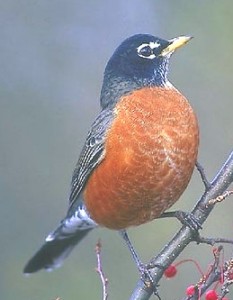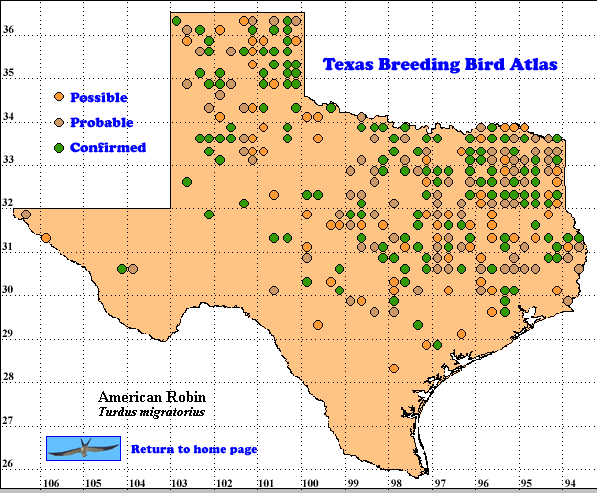American Robins are among the most familiar birds in North America, particularly in the eastern part where they are often seen on lawns in yards and parks in spring and summer as they forage for earthworms. In fall and winter when many populations move southward or to lower elevations, their diet shifts from soft invertebrates to berries and small fruits. Flocks of hungry robins check berry bushes frequently, monitoring the status of the fruit (Sallabanks and James. 1999).
DISTRIBUTION. During the 1987-1992 field work seasons of the TBBA project, researchers found confirmed breeding evidence for American Robins in 178 blocks, probable evidence in 143 blocks and possible evidence in 163 blocks. The thickest concentrations of breeding was found in the Pineywoods, Post Oak Savannah and Blackland Prairies eco-regions and the :Panhandle (see the region map in Lockwood and Freeman [2004]). Breeding was more scattered in the remaining parts of the High and Rolling plains and Coastal Prairies regions with only a few records from other regions. In Oklahoma robins are widely distributed throughout the state during the breeding season (Young 2004).
North American Breeding Bird Survey (BBS) data show American Robins present in the United States and southern Canada with the exception of the Gulf Coast states (Sauer et al. 2008). In Mexico robins breed in the western and central highlands. In winter most robins breeding in Canada move south into the United States and Mexico north of the Isthmus of Tehuantepec (Howell and Webb 1995, Sallabanks and James. 1999).
SEASONAL OCCURRENCE American Robins are present all year in Texas. Migrants from further north augment the breeding population to a status of common to abundan from early November to late March. Robins breed in Texas from early March to August, based on young in the nest from March 28 to August (Oberholser 1974, Lockwood and Freeman 2004).
BREEDING HABITAT. American Robins breed in Texas from near sea level to about 2400 m (8000 ft) . They are found in forests, thickets in prairies, agricultural areas such as orchards and pastures with woodland fringes and frequently around human habitations from farm houses to city parks. In the Trans-Pecos breeding has been confirmed in the montane coniferous forests of the Davis and Guadalupe mountains (Oberholser 1974, Lockwood and Freeman 2004).
Young (2004) describes the extensive use of human-created habitats by robins in Oklahoma. Creation of these habitats allowed robins to colonize western Oklahoma. In Mexico (Howell and Webb 1995), Colorado (60%; Pantle 1998) and Arizona (56%; Wise-Gervais 2005) most robins breed in montane coniferous habitats, as they do at the higher elevations in the Trans-Pecos.
In these varied habitats female American Robins often place their nests in shrub and tree crotches or on horizontal limbs. Where houses and other structures are available, robins in eastern North America may use them as nest supports. Females constructs nests using grass and plant stalks, reinforced with dried mud. The outside diameter of nests is about 16.5 cm, (6.5 in), height 7.6 cm (3 in), inside diameter 10 cm (4 in) and cup depth 6.4 cm (2.5 in; Harrison 1979, Sallabanks and James. 1999).
On the fine grass lining of the nests female robins usually lay 3-4 (range 2-5) smooth, blue-green, unmarked eggs. Females incubate the eggs for 12-14 days. Young robins leave the nest 9-16 days after hatching and remain with their parents within150 m (500 ft) of the nest for at least 3 weeks.. During this time the female may build another nest and lay a new clutch. When she begins incubating, the male continues attending the young. Pairs normally raise 2 or even 3 broods per season (Harrison 1979, Sallabanks and James. 1999).
STATUS. Lockwood and Freeman (2004) list American Robins as common summer residents in the northern half of Texas. BBS data for 1980-2007, derived from 55 routes in this state, do not produce a statistically significant trend for Texas since the relative abundance for most of the state is less than one robin per 40 km (25 mi) route. The statistically significant North American trend for the same period, derived from 3437 routes, is +0.2% indicating a stable population across the continent (Sauer et al. 2008).
Text by Robert C. Tweit (2009)
Literature cited
Harrison, H. H. 1979. A field guide to western birds’ nests. Houghton Mifflin, Boston, MA.
Howell, S. N. G. and S. Webb. 1995. A guide to the birds of Mexico and northern Central America. Oxford University Press, New York.
Lockwood, M. W. and B. Freeman. 2004. The TOS handbook of Texas birds. Texas A&M University Press, College Station.
Oberholser, H. C. 1974. The bird life of Texas. University of Texas Press, Austin.
Pantle, D. D. 1998. American Robin (Turdus migratorius). In Colorado breeding bird atlas, pp. 396-397 (H. E. Kingery, ed.). Colorado Bird Atlas Partnership, Denver.
Sallabanks, R. and F. C. James. 1999. American Robin (Turdus migratorius), The Birds of North America Online (A. Poole, Ed.). Cornell Lab of Ornithology; Ithaca, NY: Retrieved from: http://bna.birds.cornell.edu/bna/species/462
Sauer, J. R., J. E. Hines, and J. Fallon. 2007. The North American breeding bird survey, results and analysis 1966-2006. Version 7.23.2007. USGS Patuxent Wildlife Research Center, Laurel MD < http://www.mbr-pwrc.usgs.gov/bbs>
Wise-Gervais, C. 2005. American Robin (Turdus migratorius). In Arizona breeding bird atlas. pp. 440-441 (T. E. Corman and C. Wise-Gervais, eds.). University of New Mexico Press, Albuquerque.
Young, E. A. 2004. American Robin (Turdus migratorius). In Oklahoma breeding bird atlas, pp. 332-333 (D. L. Reinking, ed.). University of Oklahoma Press, Norman.

